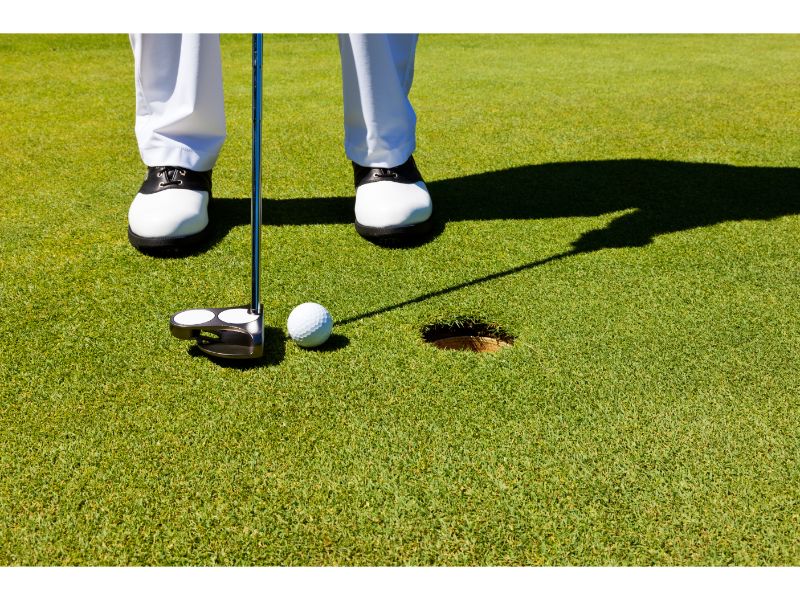Putting is one of the most critical components of a golfer’s game. It’s a skill that can make or break your scorecard. Improving your putting requires focus and determination in perfecting your technique.
Golfers who are struggling with their putter are best to focus on their technique for improvement. However, when all else fails, changing your putter or adjusting its specifications may be needed. Adjusting your putter weight, specifically adding weight, is a common modification used to enhance control and consistency.
In the article below, we will cover all you need to know about adding weight to your putter head. From the effects of adding weight to your putter to how to add weight properly. We have a lot to cover so let’s get started!
Should I Add Weight To My Putter Head?
First and foremost, it is important to recognize that increasing the weight of your putter head can have both beneficial and bad consequences on your game.
A heavier putter head can help you maintain a smoother, more consistent stroke. It can also assist you in hitting the ball with more power and accuracy, particularly on longer putts.
Adding too much weight to your putter head, on the other hand, can produce issues. It might make your putter feel heavy, which can disrupt your stroke and rhythm. It can also make controlling the speed and direction of your putts more difficult, leading to missed putts and higher scores.

So, should you putt with more weight? The answer is determined by a number of factors. Personal preference, putting style, and the sort of greens you usually play on are all important to consider.
If you prefer a heavier putter and believe it helps you make more putts, adding weight to the head of your putter could be a good option. A heavier putter head may also be advantageous if you play on fast greens and need greater control over your putts.
If you like a lighter putter and have a more sensitive putting stroke, adding weight could be damaging to your game. It may disrupt your rhythm and make controlling the speed and direction of your putts more difficult.
Ultimately, the decision to add weight to your putter head comes down to personal preference and experimentation. You may need to try different weights and configurations to find what works best for you. If you’re unsure, consult with a professional golf club fitter or instructor who can help you make the right choice.
What Is The Average Weight Of A Putter Head?
The typical weight of a putter head varies according to the type of putter and the preferences of the player.
That said, most putter heads weigh between 310 and 350 grams. This weight range is appropriate for the majority of players because it gives the ideal blend of stability, control, and feel on the green.
Yet, based on their particular preferences and putting style, some players choose a heavier or lighter putter head. Some golfers, for example, may choose a heavier putter head to aid in more consistent strokes. Whereas others may prefer a lighter putter head for greater speed control.
Another thing to think about when deciding on the weight of your putter head is the sort of greens you usually play on. If you play on quicker greens, a lighter putter head may be necessary to assist you regulate the speed of your putts.
A heavier putter head will typically help you create greater force and precision on your putts if you play on slower greens.

What Are The Effects Of Adding Weight To Putter Head
Adding weight to your putter head can have both positive and negative effects on your game. Here are some of the effects you might experience:
- Improved Stability: Adding weight to your putter head can make it more stable during your putting stroke, helping you maintain a smoother, more consistent stroke.
- Increased Power: A heavier putter head can help you generate more power and speed on your putts, especially on longer putts.
- Better Accuracy: With a heavier putter head, you may find that you can hit your putts with more accuracy, as the added weight can help you maintain a straighter stroke.
- Reduced Feel: Adding too much weight to your putter head can reduce your ability to feel the ball off the face of your putter. This can make it harder to control your putts.
- Reduced Control: Adding too much weight to your putter head can make it harder to control the speed and direction of your putts. This can lead to missed putts and higher scores.
Ultimately, the effects of adding weight to your putter head depend on your personal preferences, putting style, and the type of greens you typically play on. It’s essential to experiment with different weights and configurations to find what works best for you.
It’s also important to note that adding weight to your putter head should be done in moderation. Adding too much weight can throw off the balance of your putter, making it more difficult to use. Consulting with a professional golf club fitter can help you find the right weight for your putter head.
Is It Legal To Add Weights To A Putter?
The total weight of a putter cannot exceed 50 ounces. Also, the clubhead must be composed of metal or other authorized materials, according to the rules. You can add weights to your putter without breaking any restrictions if the increased weight does not exceed these limits and the clubhead is made of an authorized material.
It is important to remember, however, that some golf contests and tournaments may have special rules regulating equipment alterations, such as putter weights. Before making any changes to your equipment, always verify with the event authorities or the rules committee.
Adding weights to your putter can have several benefits, including improving stability, control, and feel. It can also help you generate more power and accuracy on your putts. However, it’s important to note that adding too much weight can throw off the balance of your putter, making it more difficult to use.

How To Add Weight To A Putter? 4 Easy Steps
Determine The Desired Weight:
Before adding weight to your putter, you need to determine how much weight you want to add. Adding too much weight can throw off the balance of your putter, making it more difficult to use. A professional club fitter or instructor can help you determine the ideal weight for your putter based on your putting style and the greens you typically play on.
Choose The Right Weights
There are different types of weights you can use to add weight to your putter, including lead tape, tungsten weights, and steel weights. Lead tape is the most common and easiest to use, as it can be cut to size and applied directly to the clubhead.
Apply The Weights
Once you have determined the desired weight and chosen the right weights, it’s time to apply them to your putter. If using lead tape, cut it to size and apply it to the back of the clubhead. Make sure to apply the tape evenly and avoid adding too much weight to any one area.
Test The Club
After adding the weights, test your putter to see how it feels and performs. If it feels off-balance or too heavy, you may need to remove some of the weights or adjust their placement. A professional club fitter or instructor can help you make any necessary adjustments.
Check The Club Regularly
It’s important to check your putter regularly to ensure the weights are secure and have not shifted. Loose weights can affect the balance of your putter and impact your performance.
Final Thoughts
Your putting game can be improved by adding weight to your putter, but it must be done properly to prevent breaking the club or having a bad effect on your performance. Establish the desired weight, make the appropriate weight selections, equally distribute them over the clubhead, test the club, and inspect it frequently. You can identify the ideal weight and configuration for your putter by speaking with a qualified club fitter or instructor.
Hopefully, you liked this article and found it informative. Check out our other blog posts if you liked this one!


